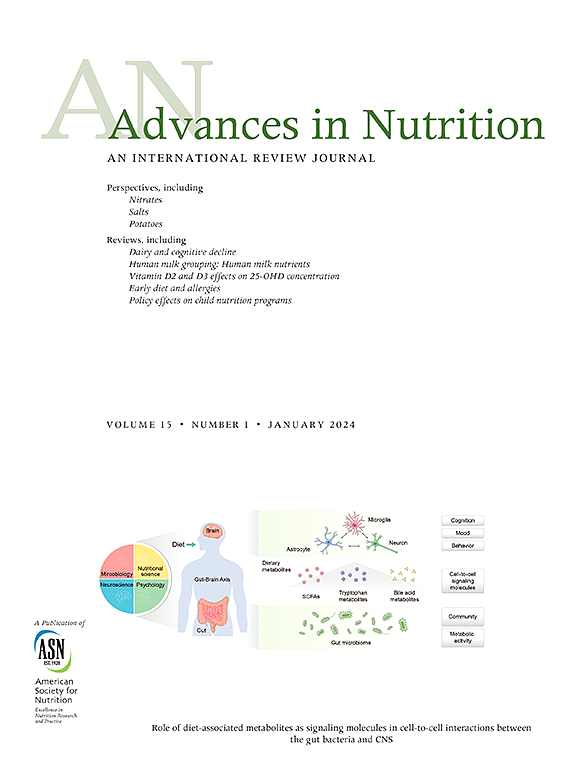Absorption of Iron Naturally Present in Soy
IF 9.2
1区 医学
Q1 NUTRITION & DIETETICS
引用次数: 0
Abstract
Plant-based foods can offer sustainable and healthy dietary choices. Soybeans and derivatives (for example, flour, concentrate, or isolate) are the primary protein source for plant-based products, including meat analogs, and are naturally rich in iron. To investigate the nutritional contribution of iron naturally present in soy, this narrative review presents iron bioavailability data from isotope studies in humans aged >3 y. To allow interstudy comparison, we adjusted mean iron absorption for iron status (that is, serum ferritin of 15 μg/L), quantified native iron absorbed, and compared with daily human requirements for absorbed iron where possible. Adjusted iron absorption from soybeans served as part of meals varied widely (4.1%–22.2%), translating to contributions of 13%–70% and 10%–40% to the daily requirements for absorbed iron in adult males and females, respectively. Similar results were found for meals prepared with soy flour (full fat, defatted, and texturized) and soy protein concentrates, whereas iron bioavailability from soy protein isolates may be reduced. Within a meal, partial substitution (≤30%) of meat with soy concentrates and isolates did not meaningfully impair total iron absorption. In all conditions, low phytic acid levels and co-ingestion of ascorbic acid improved the absorption of iron naturally present in soy. Available evidence suggests that soy-based products can provide a meaningful contribution to daily requirements for absorbed iron, especially if phytic acid is below defined thresholds to optimize absorption and/or if products include iron absorption enhancers such as ascorbic acid. Further research is needed to understand the factors affecting iron bioavailability from these products, especially the soy cultivar, the roles of phytoferritin and the protein profiles of different soy protein ingredients, as well as the processes to produce them. Long-term assessments of the impact of soybean-based products on iron status are also warranted.
吸收天然存在于大豆中的铁。
植物性食品可以提供可持续的健康饮食选择。大豆及其衍生物(如面粉、浓缩物或分离物)是植物性产品(包括肉类类似物)的主要蛋白质来源,天然富含铁。为了研究大豆中天然铁的营养成分,本综述介绍了对 3 岁以上人群进行同位素研究得出的铁生物利用率数据。为了进行研究间的比较,我们根据铁的状况(即血清铁蛋白为 15μg/L)调整了平均铁吸收率,量化了吸收的原生铁,并尽可能与人体每日对吸收铁的需求量进行比较。膳食中大豆的调整铁吸收率差异很大(4.1%-22.2%),分别占成年男性和女性每日铁吸收需求量的 13%-70% 和 10%-40%。用大豆粉(全脂、脱脂和膨化)和浓缩大豆蛋白制作的膳食也发现了类似的结果,而大豆分离蛋白中铁的生物利用率可能会降低。在一餐中,用浓缩大豆蛋白和大豆分离蛋白部分替代肉类(≤30%)并不会明显影响铁的总吸收量。在所有条件下,植酸含量低和同时摄入抗坏血酸都能促进对大豆中天然铁的吸收。现有证据表明,大豆制品能有效满足人体对铁的日常吸收需求,特别是当植酸低于规定的阈值以优化吸收和/或产品中含有铁吸收促进剂(如抗坏血酸)时。要了解影响这些产品中铁生物利用率的因素,尤其是大豆品种、植物铁蛋白的作用、不同大豆蛋白成分的蛋白质特征以及生产工艺,还需要进一步研究。此外,还需要对大豆制品对铁状况的影响进行长期评估。
本文章由计算机程序翻译,如有差异,请以英文原文为准。
求助全文
约1分钟内获得全文
求助全文
来源期刊

Advances in Nutrition
医学-营养学
CiteScore
17.40
自引率
2.20%
发文量
117
审稿时长
56 days
期刊介绍:
Advances in Nutrition (AN/Adv Nutr) publishes focused reviews on pivotal findings and recent research across all domains relevant to nutritional scientists and biomedical researchers. This encompasses nutrition-related research spanning biochemical, molecular, and genetic studies using experimental animal models, domestic animals, and human subjects. The journal also emphasizes clinical nutrition, epidemiology and public health, and nutrition education. Review articles concentrate on recent progress rather than broad historical developments.
In addition to review articles, AN includes Perspectives, Letters to the Editor, and supplements. Supplement proposals require pre-approval by the editor before submission. The journal features reports and position papers from the American Society for Nutrition, summaries of major government and foundation reports, and Nutrient Information briefs providing crucial details about dietary requirements, food sources, deficiencies, and other essential nutrient information. All submissions with scientific content undergo peer review by the Editors or their designees prior to acceptance for publication.
 求助内容:
求助内容: 应助结果提醒方式:
应助结果提醒方式:


